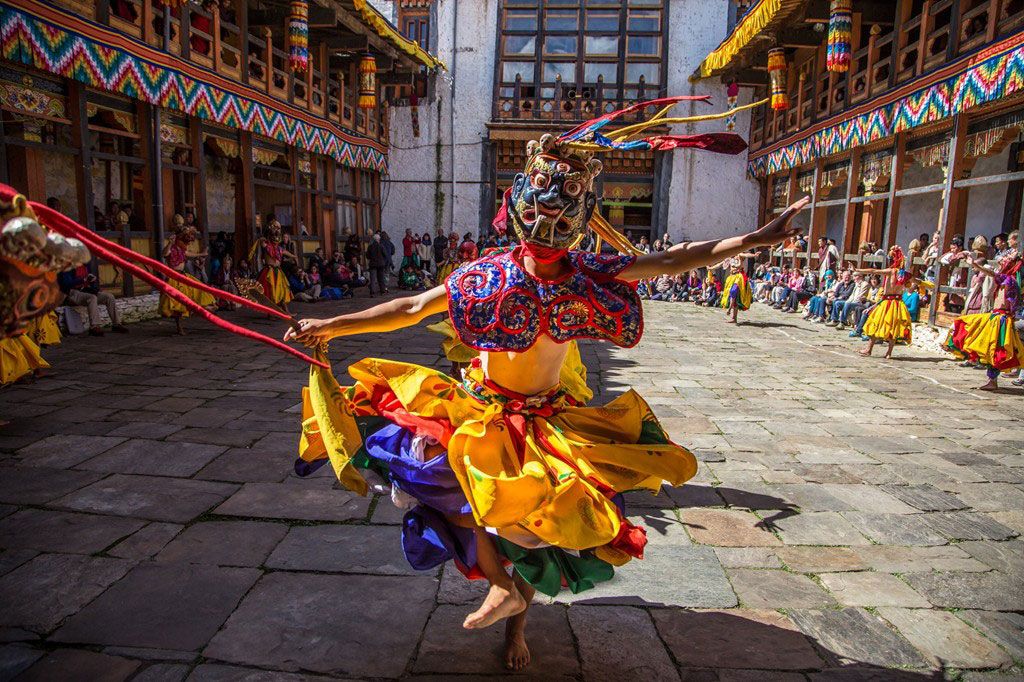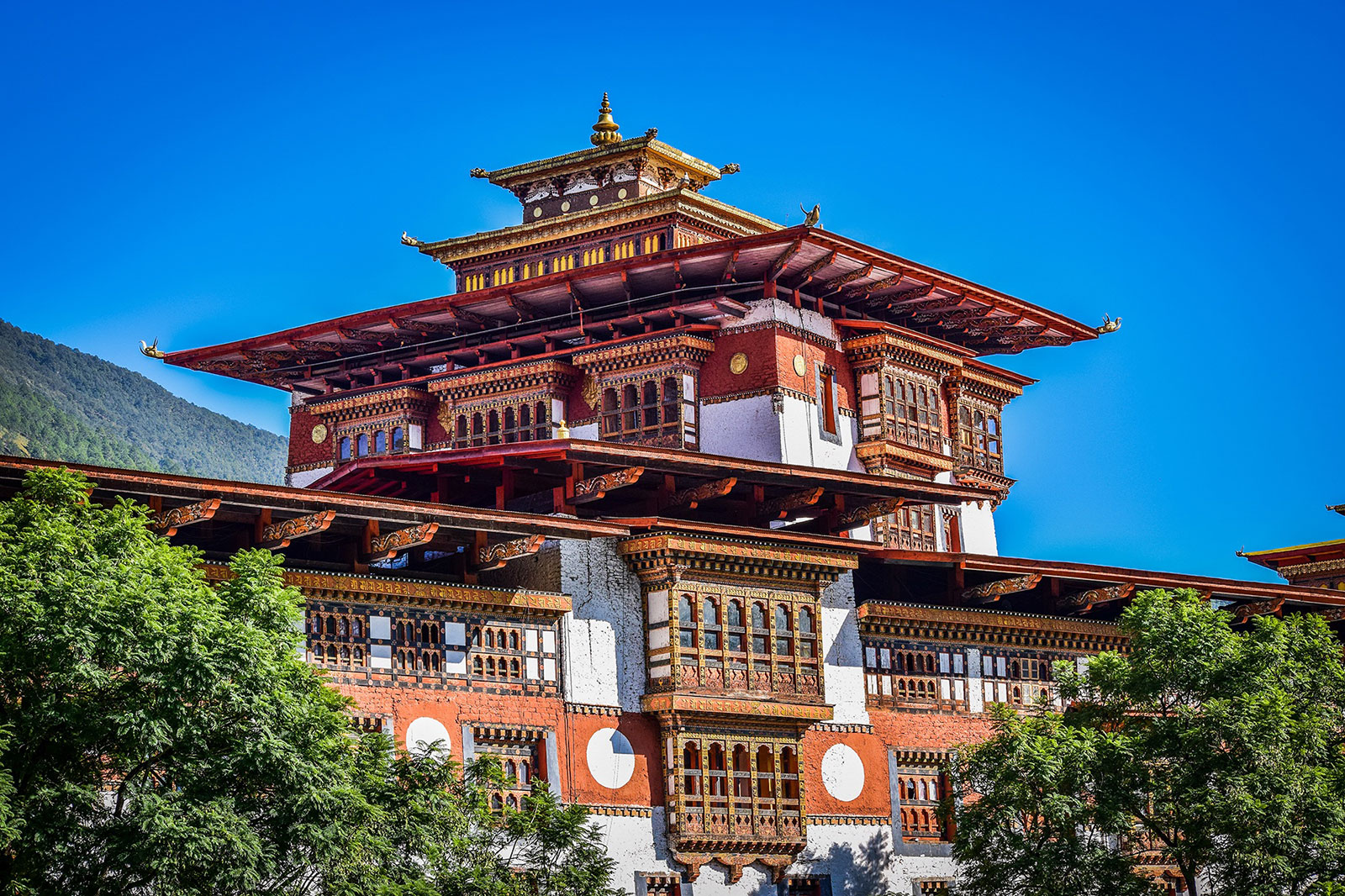Western Bhutan Tour (8 days) is tour program designed in such a way that when you travel or tour in Bhutan one can experience the gift of Western Bhutan with beautiful mountains and valleys. It offers stunning scenery with golden paddy fields cascading down the magnificent mountains, the pristine rivers flowing through the main towns of Paro, Thimphu and Punakha, and unique two-story houses displaying rich traditional paintings and architectural designs.
Thimphu is Bhutan’s capital city with a population of around 100,000 people. It is also Bhutan’s largest city. The city’s main thoroughfare is lined with shops, restaurants, and public buildings, and the rest of the city comprises apartments, small home, and family-owned stores. All buildings are built in traditional style featuring Buddhist motifs, lending a unique air to the city that attracts travelers of all kinds.
The surrounding valley has been the site of small settlements for centuries, but the area only began to truly develop after it was named the new capital in the early 1960’s. The city is home to numerous cultural attractions, including monasteries, museums, government buildings, botanical gardens, and traditional art centers as well as bustling weekend markets.
Paro is another important town of western Bhutan. Just outside of the town, visitors can find the famous Tiger’s Nest hermitage, built on a sheer cliff face. It is believed that the father of Bhutanese Buddhism flew to the cliff on the back of a tigress; therefore Buddhists consider the hermitage highly sacred. Also in the valley are the ruins of Drugyal Dzong, large fortress-monastery that was partially destroyed by fire in the early 1950’s.
Paro is the home of Bhutan’s international airport, and the area features a number of fascinating architectural relics including a fifteenth century temple and the Ugyen Perli Palace.
DAY 01 ARRIVE PARO & DRIVE TO THIMPHU
As you approach Paro, on clear sunny days you can capture a spectacular view of Himalayan peaks. Just before landing, you will have unusual experience with the aircraft as it prepares to land on one of the most difficult airports in the world. On arrival you will be received by our representative who will then drive you to Thimphu, which is about 1.5 hour drive from Paro. Thimphu is at the elevation of 2500 meters / 8200ft.
Overnight at hotel in Thimphu.
DAY 02 SIGHTSEEING OF THIMPHU VALLEY
Visit King Jigme Dorji Wangchuk Memorial Chorten, Dupthop Lhakhang ( Monastery for the nuns), National Library, the Painting School where traditional art is kept alive through instructions in the art of painting Thangkhas ( sacred Buddhist religious scrolls), and the Institute of Medicine where traditional medicines are prepared according to ancient practices. After lunch at a local restaurant, you will visit Lungtenzampa to observe the traditional silver smiths plying at their crafts and the Bhutanese traditional paper factory. Drive back to town and visit the handicraft stores and stroll around the tiny capital city.
Overnight at Hotel.
OPTION: If you are in Thimphu during Friday Saturday and Sunday then the sightseeing will
Visit Farmers’ Centenary market in Thimphu, which is in a permanent set of stalls. The market was opened in 2008 to celebrate 100 years of monarchy in Bhutan. Vendors from throughout the region arrive on Friday afternoon and remain selling their goods until Sunday night. It’s an interesting place to visit, where village people jostle with well-heeled Thimphu residents for the best and cheapest vegetables and foodstuffs. This is the only time that fresh produce is easily available and the shopping is enhanced by the opportunity to catch up on the week’s gossip. At the northern end of the market are stalls called indigenous goods and handicrafts section. Here you will find locally produced goods, including religious objects, handmade metal swords and knives, baskets, fabrics and different hats from various minority groups. Your sightseeing will continue to Zangdopelri temple in Changlimithang where you can witness young Bhutanese practicing their favorite archery game. We will return to hotel for lunch. After lunch, you will visit the Memorial Chorten built in honor of the late King Jigme Dorji Wangchuk, Dupthop Lhakhang (Monastery for the nuns) and other places of interest.
DAY 03 THIMPU-PUNAKHA
Leaving Thimphu the road ascends steeply through a forest of pine and cedar, festooned with hanging lichen high up near Dochula pass (3050 m). This pass offers panoramic views of the Himalayan mountain ranges. Your car will drop you at the mule track, from where you will hike through the Rhododendron, Magnolia, juniper and pine forests with chirping sounds of the many rare species of birds found in Bhutan. Your picnic lunch will be served at a cosy spot. You will then be driven through the long winding road to Lobesa where you will make another hike to Chimi Lhakhang, a Temple on small hill. This temple is dedicated to the great Yogi known as Drukpa Kuenley popularly known as “Divine madman” to the westerners. Bhutanese believe that this temple blesses women who seek fertility. You will continue your drive north to visit the majestic Punakha Dzong, built on the confluence of Phochu (Male River) and Mochu (Female River). It is the most magnificent dzong of Bhutan and was the capital in the 17th and 18th century. Presently, the Dzong is the district administration and judiciary office as well as the winter seat for Bhutan’s spiritual leader Je Khenpo and the 600 monks of Thimphu and Punakha.
Overnight at hotel.
DAY 04 PUNAKHA-PHOBJIKHA-PUNAKHA
After breakfast, you will take a short drive to Wangdue at an elevation of 1,350 meters (4,430 feet). Wangdue is one of the major towns and district headquarters in western Bhutan. We will visit the Wangdue Phodrang Dzong strategically located on the ridge at the confluence of the Tsang Chu and Dang Chu rivers. We will continue our journey for another two hours and enter Phobjikha (3000 m/ 9840 feet), the valley of black necked cranes. We will drive through Oak and rhododendron forests and often witness gigantic Yaks grazing. Phobjikha is also the chosen home of the rare black-necked cranes which migrate from the central Asiatic Plateau to escape harsh winters. The other side of the pass that overlooks the valley is a realm of high altitude dwarf bamboo, the main forage for Yaks in winter. We will visit the Gangtey Monastery, perched atop a small hill that rises from the valley floor. The monastery is surrounded by a village inhabited mainly by the families of 140 gomchens (monks) of the monastery. It is the only Nyingmapa monastery in western Bhutan and the largest in the country. The monastery is headed by the spiritual master known as ninth Gangtey Tulku. We will resume our drive for few more kilometers beyond the monastery to the village of Phobjikha. We will drive back to Punakha, about four hours from Phobjikha.
Overnight at Hotel. Picnic lunch will be served.
DAY 05 PUNAKHA-PARO
After Breakfast, we will drive to Paro and stop at Dochula Pass to take photographs and explore the recently built stupas. On clear sunny days, you can view the Bhutan’s 200 mile snow-capped peaks in the north. From Dochula, you will drive down and stop at the oldest Simtokha Dzong, built in 1629 by Zhabdrung Ngawang Namgyal. It now houses the institute of traditional studies for lay men and women. We will continue our drive and eat lunch in a local restaurant in Thimphu. After lunch, you will have about an hour to do the last minute shopping before you resume journey to Paro. On your way to Paro you will stop at the Tachogang Temple, built in the 15th century by Thangtong Gyalpo, who also built several iron bridges in Bhutan. We will resume our drive to Paro and check in to Hotel.
Overnight at Hotel.
DAY 06 SIGHTSEEING OF PARO VALLEY
After breakfast, you will visit Drukgyal Dzong built in 1647 by Zhabdrung Ngawang Namgyal. The Dzong was built to commemorate the victory against the invading Tibetan army in 17th century. The Dzong was destroyed by fire and left in ruins. On a clear day you can get a magnificent view of Mount Jhomolhari (7314 m / 23,990 ft). From Drugyal Dzong, we will drive south to Satsam Chorten, built in memory of the late Dilgo Khentse Rinpoche, and continue on to Kyichu Lhakhang, built in seventh century by a Tibetan King, Songtsen Gonpo. After lunch in a local restaurant, we will visit Ta Dzong, the National Museum of Bhutan, which has collection of works of art, handicrafts, costumes, armor and rare stamps. We will take a short hike down to Rimpung Dzong. The short hike will take you through a traditional cantilever bridge and to your waiting car at the valley floor. Depending on time, we will hike up to the nearby hill to get a panoramic view of the Paro Valley.
Overnight at hotel.
DAY 07 PARO (EXCURSION TO TIGER’S LAIR)
After breakfast, your car will drop you at the starting point of the excursion tothe spectacular Taktsang monastery (Tiger’s nest). The steep trail to the monastery will take you through beautiful pine forest, many of the trees festooned with Spanish moss, and an occasional grove of fluttering prayer flags. You will love to stop at the cafeteria for refreshment after a steep climb. If not tired, you will hike further until you get a clear view of Taktsang monastery. Built in 1600s, this incredible monastery clings to the edge of a sheer rock cliff that plunges 900 meters into the valley below. The history states that Guru Padmasambhava, the Tantric mystic who brought Buddhism to Bhutan, landed here on the back of a flying tiger. Lunch will be served at the cafeteria.
Overnight at Hotel.
DAY 08 DEPART PARO BHUTAN
Our tour leader will drive you to the Paro International Airport for departure to your onward destination.









